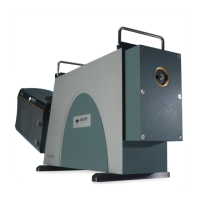62
Version 4.2 rev 06 Oct 2020
8.2 x 8.2 mm / 512 x 512 sensor
Lowest Noise Imaging EMCCD
Mechelle
b1.1- grating equation
• mλ = d (sinα + sinβ) →mλ
m
= k → λ
m
overlap
• β > 0 when incident and diffracted rays on the same side of grating normal
• Max. intensity for wavelengths satisfying the grating equation at angles α + β
0
= 2θ→mλ
m
= d (sinα + sinβ
0
)
• Special case α = β
0
= θ = condition for auto-collimation
The design of the echelle system can be optimised for resolution giving λ/Δλ ~5 x 10
4
, however this would only have a
bandwidth of ∼60 nm. To simultaneously observe a broad atomic spectrum, from 200 nm, where line density is high, to
~920 nm (main spectral response for sulphur species), the resolution will be in the region of 5 x 10
3
.
Figure 29: Schematic representation of echelle grating order-sorter combination
b1.2 - ecHelle layout
The layout of the echelle is shown in gure 30 below. The patented, dispersion balanced order sorting system provides
a uniform distribution of the spectral orders. The order sorter works like an achromatic lens, correcting the non-uniform
order distribution caused by a single prism order sorter, as used in other échelle spectrographs. This results in efcient
use of the sensor area and allows a large bandwidth to be easily achieved.
Figure 30: Optical layout of the echelle design
Figure 31 Shows the Mechelle layout using a patented combination of prisms and grating to obtain equally spaced
orders at the focal plane of the instrument, as well as simultaneous large bandpass and high spectral resolution.

